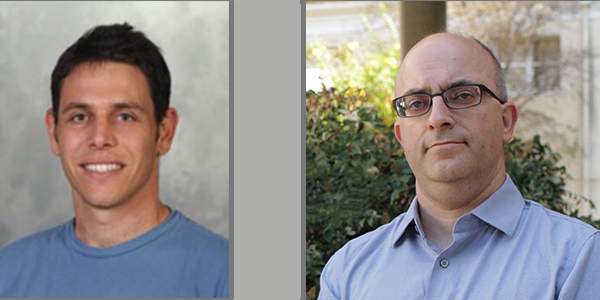Are you a journalist? Please sign up here for our press releases
Subscribe to our monthly newsletter:
Ever wonder how certain memes or videos go viral on social networks? This is an example of collective behavior. Recent research at the Weizmann Institute of Science adds a new twist to the connection between individual and collective behavior – showing that groups might function best when individuals “go their own way.”
This somewhat surprising finding arose from research by graduate student Ehud Karpas, Prof. Elad Schneidman and former student Adi Shklarsh in the Institute’s Neurobiology Department. They created mathematical models to address the question of how collective behavior arises from the decisions of numerous individuals. These models may help provide new frameworks for understanding collective behavior in real-world communities,such as schools of fish, bacterial colonies, networks of neurons or groups of people.
Two agents 'going their own way'
The study focused on models that simulate how long – or how many steps – it will take an "agent" to seek a weak source in a noisy environment, something like an animal looking for food in a forest. The present work arose from a model developed around decade ago by biophysicists in the University of California at San Diego and Santa Barbara suggesting that foraging by looking for information about the goal (rather than heading straight to a likely location) is a better strategy in noisy environments, and that this is what animals may do in nature. This idea was named “infotaxis” (taxis, from the Greek: movement in response to a stimulus). These models predict that information-seeking animals will follow a spiral path (resembling ones seen in nature), allowing them to gather evidence and test their “estimates” about the location of a food source as they forage.
Karpas, Shklarsh and Schneidman, in research that was recently published in the Proceedings of the National Academy of Sciences (PNAS), took the infotaxis model one step further and asked how it would apply to groups of agents or animals searching for food or foraging for other resources. Karpas says: “Each one can see or hear the other animals and use this to get important information.”
Simulation showing two agents averaging their information
They began by modeling two situations – one in which foraging animals simply ignore one another and the other in which all information is shared and decisions are made collectively. Intuitively, collective information sharing should grant an advantage; and that is, indeed, what they found. But this sharing of information and decisions is not really found in nature. The scientists therefore looked for a middle ground, in which some information is shared and the recipients average this with what they already “know.” That averaging, says Schneidman, is the way that many models in physics and biology deal with noisy signals and uncertainty, as it reduces the noise. However, these “middle ways” did not really help the animals in their models find the “food.” “This failed miserably,” says Schneidman. “In fact, in most cases, they would ‘dance’ around each other and never find the food.”
The team then considered the opposite scenario: Each animal tries to be as different as possible from the others. Karpas: “We basically told each 'animal' to solve the problem, by thinking differently from the rest. This worked surprisingly well." Schneidman: “The foraging was as efficient as when the entire group had all the information and made collective decisions. In fact, the more each cared about being different, the better the model worked.” The reason this model is so efficient may be that diversity can help the animals cover the space more resourcefully.
Large groups highlight the advantages of socialtaxis
The scientists then used their model, which they dubbed “socialtaxis,” to ask questions about the nature of the information one member of the group receives from another. For example, they asked what would happen if each animal gave away only one piece of information? The model worked even better with less information – apparently because this reduced the noise in the information passed between individuals.
Even without any intentional communication at all between the animals, the model showed that their very movements contained information the others could use: If one animal did something surprising – say turned off in a new direction – the others could interpret this change in behavior as informative. Schneidman explains: “If I’m a rabbit and I want to eat carrots, I assume when I see another rabbit that he thinks and behaves like me. So when an unanticipated shift in his behavior occurs, I can infer that he has discovered a carrot patch or is running away from a predator.”
This model worked quite well, though not as well as the one in which information was shared through direct lines of communication between animals.
Schneidman: “Rather than framing the question of collective behavior in terms of kinship or friendship, we can ask what the other members of the group are telling me about the world – how I can improve my knowledge of the world through them.

“Socialtaxis ties together individual and group behavior in a new manner, suggesting that very successful groups can be made up of individuals who ‘go their own way’.” The model may apply to many domains – to herds and to schools of fish, but also to antibiotic resistance, which is known to increase with diversity among the bacteria. Politics rises to mind when thinking about group behavior, but the model can also apply to more mundane things like problem solving among scientists. If two are trying to solve the same problem, for example, they might each use the information they have shared to seek alternate, individual approaches to the solution.
Prof. Elad Schneidman's research is supported by the Jeanne and Joseph Nissim Center for Life Sciences Research; the Adelis Foundation; and Martin Kushner Schnur. Prof. Schneidman is the incumbent of the Joseph and Bessie Feinberg Professorial Chair.